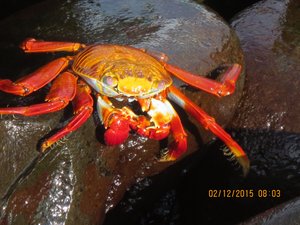Advertisement
Published: June 22nd 2017

 Amazing colours
Amazing colours
It's quite blue around its mouth parts, too. Shell width is about 100mm.Geo: -1.3761, -89.6841
We motored for 4hrs overnight to Isla Espanola - in the south of the group and our guide's favourite island. It is low and has low vegetation. After breakfast we went ashore at Punta Suarez to walk around for a few hours, keeping mostly to a marked track.
The wildlife is so abundant we had to be careful not to step on a basking iguana, or a nesting boobie bird. No exaggeration! They are unafraid of humans - a mockingbird will hop between your legs, a sea lion pup waddled up to have a sniff of Robyn, iguanas just ignore you. As we came ashore we were greeted by hundreds of multi-coloured crabs, a sea lion and her pup born that morning, marine iguanas, lava lizards, and many varieties of birds, including albatross.
12 adult tortoises were left on the island in 1972, and no juveniles. Rats kept eating any young that were borne. So the 12 (10 females and 2 males) were taken off to another island and kept in an enclosure to breed and be protected. A third male of the same sub-species was introduced to improve the genetic diversity. In the last few years the rats have been

 Marine Iguana
Marine Iguana
The iguanas have adapted to the cold of the ocean. First they sun themselves to get their body temp to the ideal 35deg. Then they enter the sea to eat algae, diving as deep as 12m and staying underwater for up to an hour at a time. When their body temp lowers, they regulate their heartbeat down as low as 6bpm and thus they can tolerate the cold. When they return to land, they have to lie in the sun or on warm rocks to raise their temp for digestion to occur. On Espanola Island there are no land iguanas, and their marine variety grow to a bit over 1m in total length. There are different subspecies on each island, something that fascinated Darwin on his 1835 visit.eradicated and 1,500 tortoises have been returned to the island. A great success story, if you're not a rat!
In the afternoon we went ashore at Gardner Bay and snorkelled and watched a family of sea lions.
Advertisement
Tot: 0.286s; Tpl: 0.013s; cc: 5; qc: 45; dbt: 0.0479s; 1; m:domysql w:travelblog (10.17.0.13); sld: 1;
; mem: 1.1mb

 Amazing colours
Amazing colours
 Marine Iguana
Marine Iguana








